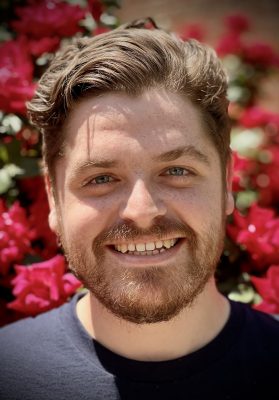Practicum Experiences and Resources
Practicum Opportunities.
Please check back soon for upcoming opportunities.
- Explore all practicum opportunities in the Gillings School Practicum Database.
- Other Startup Jobs & Internships are also available through 1789.
Student Experiences.
Interviews with students who completed a 2022 innovation-focused practicum.
Zach Witkin, YLabs

Tell us about your practicum placement and experience at a public health-focused organization using design thinking.
For my practicum, I worked for YLabs, a global design and research organization working to improve health and economic opportunity for young people aged 10–24 years. YLabs designs, tests, and advocates for youth-driven services, goods, and communications platforms to address the biggest challenges to young people’s health and economic opportunity worldwide. YLabs focuses on sexual and reproductive health, HIV/AIDS, mental health, and economic inclusion. I worked on YLabs’ inaugural US-based project, Asking for a Friend – a bilingual (English and Spanish) digital platform that will support young people to make informed decisions about their sexual health and wellness through tailored digitally-based decision-support tools and seamless connection to the sexual health products and services they need most. My main responsibility was to lead the expert interview phase of research and synthesize learnings to be used in the generation of rough prototypes that were then tested with youth and other key stakeholders in the Bay Area and Central Valley of California. Towards the end of my summer, I also helped draft a report on perceptions relating to novel male contraception in high-income countries.
Why did you want to do your practicum at an organization employing design thinking?
I’ve dipped my toe into the world of design thinking and user-centered design for quite a while, but never had the chance to fully immerse myself. As someone interested in adolescent and youth sexual and reproductive health (AYSRH), I wanted to work at YLabs because of their emphasis on youth and design thinking – the idea of designing with, not for youth. Design thinking or youth-centered design, in YLabs’ case, focuses on the ethical engagement of youth in the design process, giving them a voice to incite meaningful change in their community. Including the target community or population in all aspects of a public health intervention is one of the best ways to create innovative solutions and sustainable change. I wanted to be a part of an organization that believed in that to its core.
What knowledge gained, results produced, or enriching experience are you most proud of?
I am proud of the rich insights generated from the expert interviews I conducted. I was able to speak with a variety of stakeholders, from pediatricians and nurses to school-based sex educators, researchers on safe abortion, and Instagram-based sex educators/influencers. These experts had unique perspectives on the challenges facing young people’s sexual health and wellness journeys. I was able to synthesize the interview content into insights that informed our in-person co-design and prototyping sessions with young people, which then led to deeper conversations with young people on their lived experiences navigating their own sexual health and wellness, which was able to guide the development and iteration of our rough prototypes.
What are the key lessons that you will take away from this experience?
Flexibility is key. User-centered design projects and processes rarely go as planned. As researchers and designers, we need to be able to think on our feet and adapt to any situation. The team’s ability to be flexible paid off when I broke my foot and had to bow out of in-person co-design sessions with youth, our recruitment of young people to participate in co-design sessions, and my interviews with experts.
What was most fun or surprising about this experience?
Even though I conducted my practicum remotely, I enjoyed working with all my colleagues at YLabs. It’s evident that everyone at YLabs loves what they do, loves working with each other, and has fun doing it.
What are your plans post-graduation (it’s ok if you don’t know!) and has this experience influenced you to pursue your own social innovation or entrepreneurial endeavors? If so, tell us what you are passionate about innovating.
I don’t have any concrete plans post-graduation and am keeping my options open. However, I know that I want to work in an environment that uses user-centered design in some way related to health and social impact. I also enjoy using my technical skills around sexual and reproductive health, as well as convening partners and soliciting funding for innovative projects. Right now, I’m interested in working at a foundation, in venture philanthropy/capital, or any social impact organization that aligns with my values and places communities at the center of anything they do.

Chloe Coletta, RTI International
Tell us about your practicum placement and experience at a public health-focused organization using design thinking.
This summer, I worked as a Research Assistant with both Dr. Lauren Hill at Gillings and Laura Wagner at RTI International. The intent of the She’s PrEPared research study is to create an online decision aid to help cisgender women consider if pre-exposure prophylaxis (PrEP) is an appropriate HIV prevention method for them. The goal for my practicum was to continue developing the decision aid prototype (in Semblie, a platform built by RTI) and conduct user-testing interviews with STI clinic patients to assess preliminary usability, acceptability, and appropriateness of the online tool. After each interview, I practiced rapid iteration and human-centered design by modifying the tool based on individual user feedback to increase comprehension, decrease worriedness/anxiety among participants, and highlight important content. The final and most current version of the decision aid is a product of the reactions, emotions, and suggestions of every single participant we interviewed. How cool is that?!
Why did you want to do your practicum with a study employing design thinking?
After taking the Design Thinking for the Public Good class, I realized that I have always been an innovator and entrepreneur at heart. All of a sudden, it made sense to me that I should be employing these skills and principles into the field of study that I am most passionate about: sexual and reproductive health (SRH). I also truly believe that the future of public health is digital, whether that be digital health interventions such as the decision aid that I worked on, or health promotion marketing campaigns disseminated via social media. Being able to combine my interests of innovation, SRH, and health technology was my priority when starting the practicum search.
What knowledge gained, results produced, or enriching experience are you most proud of?
I am most proud of the rapid analysis and rapid iteration processes that I employed during my practicum this summer. Sometimes, I would have a user testing interview one day, and another one the next day, so I would have to analyze the results of the first interview and rapidly iterate upon the tool before the next interview. Being able to design newer versions of the decision aid in short time spans is something that I am very proud of. Working in public health either moves really slow, or really fast, and I’m glad that I got to practice working in both environments!
What are the key lessons that you will take away from this experience?
The most important lesson that I learned this summer is the importance of community-based participation. In public health, we often think we know what is most beneficial to a community based on past research and quantitative data. But we will never know what is truly best for our intended demographic unless we ask them. This is the beauty of human-centered design: listening to your user throughout the entire design process will ultimately help you deliver the most effective, user-friendly, and impactful product or intervention.
What was the most fun or surprising part about this experience?
The most fun and engaging part of my practicum experience was conducting qualitative user-testing interviews. I am an extrovert at heart, and I love talking with others and hearing their experiences. I truly enjoyed interviewing every participant and getting to know them. I also got the opportunity to conduct some interviews at a local STI clinic, and it was amazing getting to know the people that work there and their day-to-day activities.
What are your plans post-graduation (it’s ok if you don’t know!) and has this experience influenced you to pursue your own social innovation or entrepreneurial endeavors? If so, tell us what you are passionate about innovating.
While I do not know exactly what I will be doing post-graduation, I hope to work in the health technology or health innovation space on SRH projects. My practicum experience has absolutely transformed my idea of what I’d like to do with my career, and I will be forever grateful for that. The design thinking course and CIPG program have also influenced me (and a few other MPH students) to start our own human-centered-design-developed non-profit, called Switchback Gear Collective. Our mission is to sell second hand outdoor gear at low prices to increase accessibility to the outdoors for all. While it is not SRH-focused, I have definitely used my innovation and entrepreneurship skills gained in the program and in my practicum to strengthen our mission and vision.
